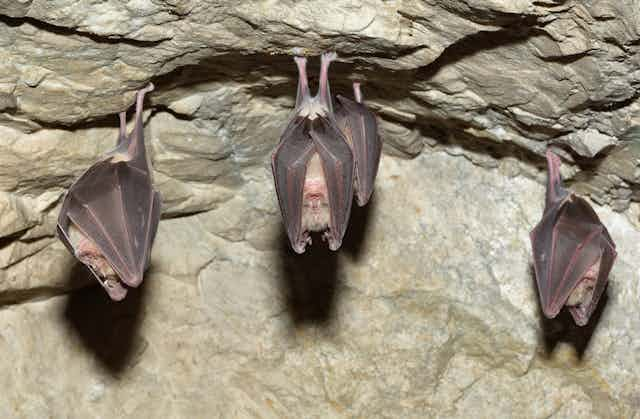The Ebola outbreak, which began over two years ago in a remote village in Guinea, West Africa, officially ended on January 14 2016. Within 24 hours of the announcement, a new case of Ebola was reported in Sierra Leone. It’s now widely accepted that there will be sporadic cases of Ebola in Guinea, Sierra Leone and Liberia for the foreseeable future.
An important piece of information, confirmed as the outbreak unfolded, was the ability of the virus to survive for up to nine months in semen and nerve cells – thought to enable the virus to be sexually transmitted and cause relapse, though this latter is still being investigated.
To make matters worse, evidence suggests that the natural reservoir of Ebola viruses is fruit bats and possibly also insectivorous bats. A previous unsuccessful attempt to eradicate the closely related Marburg virus from a colony of bats showed that it’s not easy to remove the threat these animals pose to human health.
What the UK got wrong
There have been many reviews of how organisations responded to the outbreak of Ebola in West Africa and what lessons that should be learned. But it’s not just the three countries that suffered the most during the crisis that are investigating the failings of their disease outbreak policies and practices. In the UK, the House of Commons science and technology select committee identified several national shortcomings in the wake of the crisis:
- A lack of “research readiness” to develop the necessary diagnostics, vaccines and treatments.
- A lack of capacity for large-scale vaccine manufacturing.
- Inefficient coordination and communication between government, academic, and industry bodies.
The report went on to suggest that these issues leave the UK vulnerable to future infectious disease outbreaks.
While this is true, addressing these issues will offer little help if the virus has never been seen before. The lack of immunity within the population coupled with a lack of vaccines, treatments or diagnostics means the virus could have a devastating impact. But it’s unlikely that the UK would be completely in the dark because over 3,000 different species of viruses have been identified to date, including MERS and Nipah. Scientists can also use information on existing viruses to predict which of the known emerging viruses, for which we have no or very limited treatment options, are likely to cause severe outbreaks in the near future.
Also, efforts to develop treatments that could be used to limit the size of the Ebola virus outbreak in West Africa have shown that existing approved drugs can be used to treat diseases other than those they were originally developed to target.
An ounce of prevention
Until 2014, significant funding and resources to tackle the threat of emerging viruses were not available. Developing vaccines or drugs to treat only a handful of people was not seen as economically viable by pharmaceutical companies and governments, while investment in primary healthcare infrastructure in countries most at risk was not seen as a priority.
A 2016 report commissioned by the US National Academy of Medicine concluded that US$4.5 billion a year was needed to mitigate the global risk posed by infectious diseases. A trifle compared with the estimated US$60 billion annual cost associated with pandemics.
The financial and logistical support that was provided by UK research funding agencies and the government has been widely acknowledged to have had a huge impact on how the Ebola outbreak unfolded in Sierra Leone. More recently, chancellor George Osborne, the Medical Research Council and the Newton Fund earmarked funds to strengthen the UK’s defences against emerging infectious diseases.
These pledges of extra funds may sound impressive but there is a lot that needs to be achieved, including upgrading national health systems in the UK and abroad and investing in research and development of new diagnostic tests, vaccines and therapeutic drugs.
Let’s not stall again
Many people are unaware that the work to develop several of the Ebola vaccines and treatments tested in West African clinics last year started over ten years ago. The initial studies had stalled at phase I trials (when drugs are tested on humans for the first time) due to lack of funding. The drug developers had to wait until the outbreak before money was made available for them to continue with their trials. We shouldn’t be faced with this situation again.

Unfortunately, the Zika outbreak in Central and South America followed too soon after Ebola and many of the strategies to limit its global impact – such as those recommended by the US National Academy of Medicine – were not in place. However, lessons have been learned. The WHO responded much faster and many UK scientific institutes, funders and journals have committed to make Zika virus research information rapidly and freely available.
The 2013-16 Ebola crisis and the ongoing Zika virus outbreak have galvanised UK agencies into action, but it’s important that these efforts don’t fade once the latest outbreak is under control. We don’t want to stumble unprepared into the next one.

